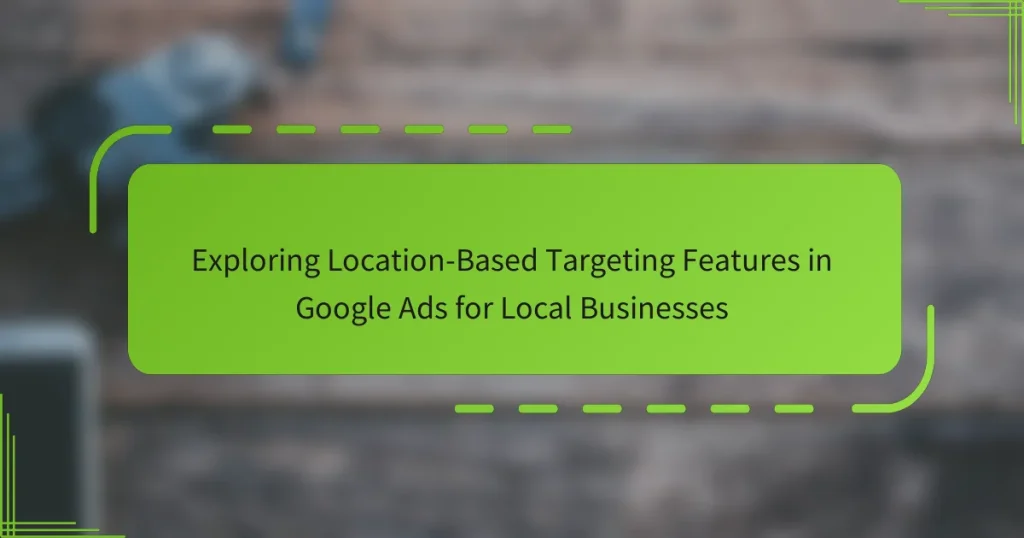Geo-targeted ads in Georgia are designed to deliver advertisements based on users’ specific geographic locations, enhancing marketing effectiveness. By tailoring messages to local contexts, businesses can reach the right audience, increasing relevance and engagement in their advertising efforts.
მობილური მოწყობილობის ტრეკინგის როლის გაგება გეო-ტარგეტირებულ რეკლამაში
წარმატებული გეო-ტარგეტირებული რეკლამირებისთვის რეალურ დროში მონაცემების მნიშვნელობა
ფეისბუქის სარეკლამო თუ გუგლის სარეკლამო სისტემებში გეო-გეგმვის ფუნქციების შედარებითი ანალიზი
სტარტაპებისთვის გეო-ტარგეტირებული რეკლამირების პლატფორმებში საძიებო ძირითადი მახასიათებლები
ადგილმდებარეობაზე დაფუძნებული სამიზნე ფუნქციების გამოკვლევა Google Ads-ში ადგილობრივი ბიზნესებისთვის
როგორ გამოიყენოთ Behavioral Targeting Geo-Targeting-თან ერთად უკეთესი შედეგებისთვის
What are the key features of geo-targeted ads in Georgia?
Geo-targeted ads in Georgia focus on delivering advertisements based on the specific geographic locations of users. This approach enhances marketing effectiveness by ensuring that the right audience receives relevant messages tailored to their local context.
Location precision
Location precision is crucial for geo-targeted ads, as it determines how accurately ads reach their intended audience. Advertisers can utilize GPS data, IP addresses, or Wi-Fi signals to pinpoint user locations down to specific neighborhoods or even streets.
For example, a restaurant in Tbilisi can target ads to users within a 5-kilometer radius, ensuring that only nearby potential customers see their promotions. This level of precision minimizes wasted ad spend and maximizes engagement.
Audience segmentation
Audience segmentation allows advertisers to categorize users based on various criteria, such as demographics, interests, and behaviors, alongside their geographic location. This enables more tailored messaging that resonates with specific groups.
In Georgia, businesses can segment audiences by regions, such as targeting ads to users in Batumi for beach-related products while promoting winter gear to users in mountainous areas. This targeted approach increases the relevance of ads and improves conversion rates.
Real-time data utilization
Real-time data utilization involves leveraging current information to optimize ad delivery and performance. Advertisers can adjust their campaigns based on real-time metrics, such as user engagement and location trends.
For instance, if a local event is happening in Tbilisi, businesses can quickly modify their ads to promote relevant products or services, ensuring they capitalize on the increased foot traffic and interest in the area.
Localized content delivery
Localized content delivery ensures that the messaging and visuals of ads resonate with the local culture and language. This approach enhances user engagement and fosters a connection between the brand and the audience.
In Georgia, using Georgian language and culturally relevant imagery in ads can significantly improve their effectiveness. For example, a campaign promoting traditional Georgian cuisine can incorporate local dialects and cultural references to attract more attention.
Performance tracking
Performance tracking is essential for assessing the effectiveness of geo-targeted ads. Advertisers can monitor key performance indicators (KPIs) such as click-through rates, conversion rates, and return on investment (ROI) to evaluate campaign success.
By analyzing these metrics, businesses in Georgia can identify which locations and audience segments yield the best results, allowing for informed adjustments to future campaigns. Regular performance reviews help in optimizing ad spend and improving overall marketing strategies.
How do geo-targeted ads improve advertising effectiveness?
Geo-targeted ads enhance advertising effectiveness by delivering tailored messages to specific geographic locations. This strategy ensures that advertisements reach the right audience, increasing relevance and engagement.
Higher engagement rates
Geo-targeted ads typically result in higher engagement rates because they resonate more with local audiences. By addressing local interests, cultures, and needs, businesses can create content that feels more personal and relevant.
For example, a restaurant promoting a special dish can target ads to users within a few kilometers of its location, leading to increased interactions and shares on social media platforms.
Increased conversion rates
When ads are tailored to specific locations, conversion rates often improve significantly. Users are more likely to take action when they see offers that are relevant to their immediate surroundings.
For instance, a local clothing store running a promotion for a limited-time sale can effectively attract nearby customers, resulting in a higher likelihood of purchases compared to generic ads.
Cost efficiency
Geo-targeted advertising can be more cost-efficient than broad-spectrum campaigns. By focusing on specific areas, businesses can allocate their budgets more effectively, reducing wasted ad spend on audiences that are unlikely to convert.
Using geo-targeting, a company can optimize its advertising budget by concentrating on regions with higher demand or potential, leading to better returns on investment.
What types of businesses benefit from geo-targeted ads in Georgia?
Businesses that operate locally in Georgia can significantly benefit from geo-targeted ads. These ads allow companies to reach potential customers based on their geographic location, making marketing efforts more effective and personalized.
Local retail stores
Local retail stores can leverage geo-targeted ads to attract nearby shoppers. By promoting special offers or events, these businesses can increase foot traffic and sales. For example, a clothing store might advertise a weekend sale specifically to users within a 10-kilometer radius.
Additionally, using location-based promotions can help retailers compete with larger chains by emphasizing their unique offerings. Highlighting local products or community events can resonate well with nearby customers.
Restaurants and cafes
Restaurants and cafes are prime candidates for geo-targeted advertising, as they can attract diners in close proximity. By showcasing daily specials or happy hour deals, these establishments can entice potential customers who are searching for dining options nearby.
For instance, a cafe might use geo-targeted ads to promote a morning coffee special to commuters within a specific area. This strategy can drive immediate traffic during peak hours, maximizing revenue opportunities.
Service providers
Service providers, such as plumbers, electricians, or landscapers, can effectively utilize geo-targeted ads to reach homeowners in their service areas. By highlighting their services and offering limited-time discounts, these businesses can generate leads from local customers actively seeking help.
For example, a landscaping service could target ads to homeowners in a specific neighborhood during the spring season when many are looking to enhance their yards. This localized approach can significantly increase conversion rates and customer engagement.
What are the prerequisites for implementing geo-targeted ads?
To implement geo-targeted ads effectively, businesses need to understand their target audience and have access to geolocation technology. These prerequisites ensure that ads reach the right people in the right locations, maximizing engagement and conversion rates.
Understanding target demographics
Understanding target demographics is crucial for successful geo-targeted advertising. Businesses should analyze their customer profiles based on factors such as age, gender, interests, and location. This information helps tailor ads that resonate with specific groups, increasing the likelihood of engagement.
For example, a local restaurant may target ads to young adults within a 10-kilometer radius, promoting special offers that appeal to their tastes. By focusing on relevant demographics, companies can create more effective marketing strategies.
Access to geolocation technology
Access to geolocation technology is essential for delivering geo-targeted ads. This technology allows businesses to pinpoint user locations through GPS, IP addresses, or mobile data. Understanding how to leverage these tools can enhance ad precision and relevance.
For instance, using geofencing technology, a retail store can send promotions to customers’ smartphones when they are within a certain distance from the store. This real-time engagement can significantly boost foot traffic and sales.
How can businesses measure the success of geo-targeted ads?
Businesses can measure the success of geo-targeted ads by analyzing various metrics that reflect engagement and conversion rates in specific locations. This involves using analytics tools to track user interactions and identifying key performance indicators that align with marketing goals.
Analytics tools
Analytics tools are essential for tracking the performance of geo-targeted ads. Platforms like Google Analytics and Facebook Insights allow businesses to monitor user behavior based on geographic data. By setting up location-based tracking, companies can see how different regions respond to their ads.
Additionally, tools such as heat maps can visually represent where users are clicking and engaging most. This data helps businesses refine their targeting strategies and allocate resources more effectively.
Key performance indicators
Key performance indicators (KPIs) for geo-targeted ads include metrics like click-through rates (CTR), conversion rates, and return on ad spend (ROAS). Monitoring these KPIs helps businesses understand which locations yield the best results and where adjustments may be necessary.
For instance, a business might find that ads perform significantly better in urban areas compared to rural ones. This insight can guide future campaigns, ensuring that marketing efforts are concentrated in high-performing regions for maximum impact.





